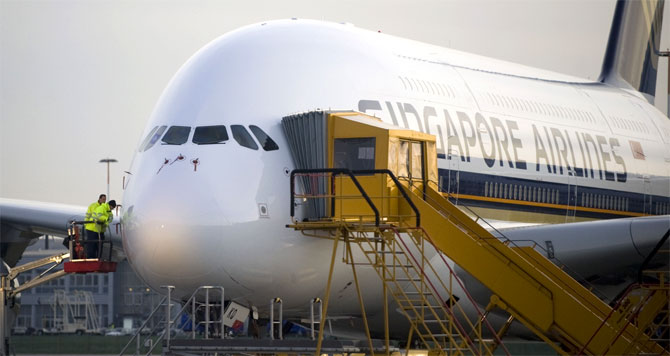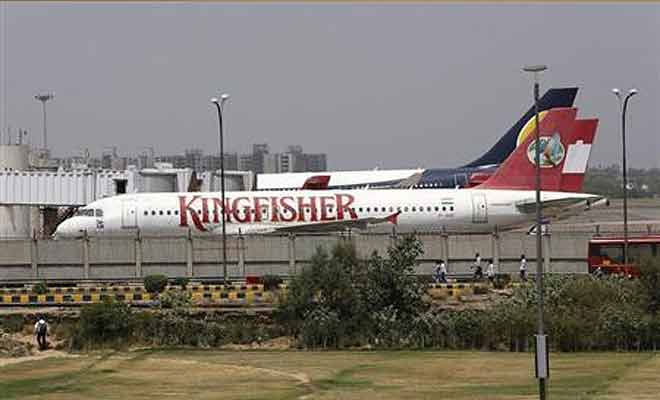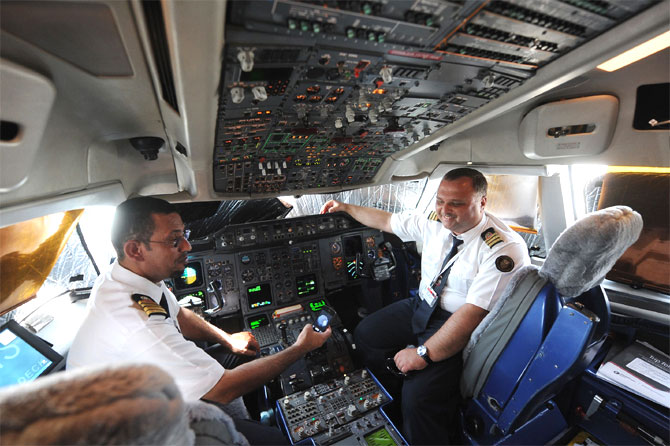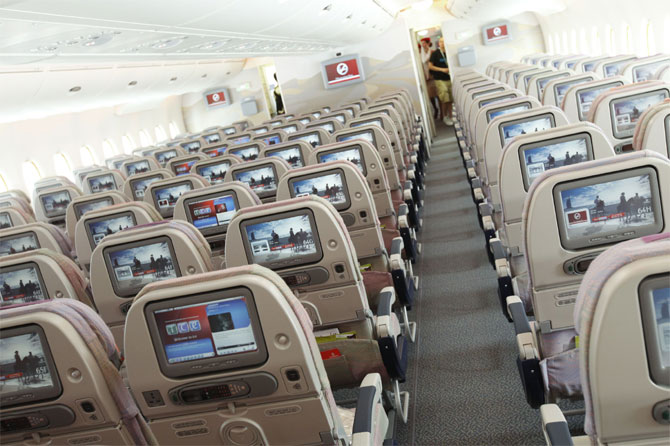
The new alliance will help the Tatas realise their long-cherished dream of flying abroad, while Singapore Airlines will get a foothold in the expanding Indian market
When Tata Sons and Singapore Airlines announced last week they will set up a full-service carrier, many were taken by surprise.
After all, 65 per cent of Indian travellers fly low-cost carriers and the market for full-service carriers has shrunk from as high as 58 per cent in September 2010 to mere 35 per cent now.
Kingfisher Airlines, which followed the full-service model, has gone belly up. Worse still, unlike the global practice, full-service carriers like Jet Airways and Air India have dropped fares to virtually the same levels as the low-cost carriers in order to maintain their market share, even though their costs are 30 to 40 per cent higher.
And if you look at incremental capacity creation this year based on new aircraft delivery, as much as 85 per cent is being deployed only for low-cost operations.
Click on NEXT for more...

That is why the aviation industry was taken by surprise when the Tatas announced that they were picking up a 51 per cent stake in the new joint-venture with Singapore Airlines.
Especially as it came just seven months after the Tata group had got into an alliance with AirAsia to grab a share of the growing low-cost carrier market.
That was, of course, understandable considering that the low-cost market is growing at a fast clip. But the Tatas also made it pretty clear of their limited role in the joint venture: they said that AirAsia, run by maverick entrepreneur Tony Fernandes, would lead the show with a 49 per cent stake and they (with 30 per cent) will be mere investors.
Yet, in the Tata-Singapore Airlines deal, the equations are completely different—the Tatas are in the driver’s seat with a 51 per cent stake and will play an active role in running the business.
So what has made them choose to play a leadership role in a full-service carrier, while leaving their partner, Fernandes, to run what surely looks like the future of the business: the low-cost carrier?
Click on NEXT for more...

Well, the answer is twofold. One, there is a market for full-service carriers which is untapped, especially after Kingfisher Airlines closed shop.
Two, the alliance is a well-thought-out long-term move for the future, positioned to create a world-class global Indian carrier once it is allowed to fly abroad.
It is true that the full-service market currently is limited to only the key metros, that too at peak timings and mostly for corporate travellers for whom price is not an issue.
But while only 5 per cent of all the passengers in the country fly business class, their share of the revenue is over 10 per cent. This shows that the margins are high. And there is a market to fill the gap left by Kingfisher Airlines which, while the going was good, ran a high-quality service.
The potential lies in the fact that even though Kingfisher Airlines’ demise caused business class capacity to fall over 30 per cent, other full-service carriers did not rush in to fill this vacant capacity.
Jet realised it only recently when despite its focus on the Etihad alliance and the more profitable international business, it decided to introduce business class seats on Jet Konnect flights.
Click on NEXT for more...

Cost factor
But the problem currently is that business class seats are too overpriced and therefore the market is languishing. That provides Tata-Singapore Airlines the opportunity to price such seats lower and grow the market.
“Today, full-service carriers charge Rs 27,000 one way between Delhi and Mumbai which is three times higher than an economy seat. Yet, when Kingfisher Airlines was there, business class tariffs were only double of economy. So if Tata-Singapore Airlines can drop tariffs and provide good service, the business class market can easily be grown,” says a top executive of a leading Indian carrier.
The other problem is that cutthroat competition has forced full-service carriers to price their economy seats at a par with the low-cost carriers.
On most routes, there is no difference between their fares, analysts say, and when there is a difference it is less than Rs 500. So there is an opportunity for the new airline to price its fares Rs 1,000 to Rs 1,500 more, provided it offers high-quality service.
“There is a corporate travellers market which is increasingly shifting to low-cost carriers. They can go back to full-service carriers if they get a premium service and also loyalty points which they don’t get in low-cost carriers,” says the same executive.
Click on NEXT for more...

But that is only for the short and medium terms. Most experts believe that the two partners are really looking at the alliance’s long-term potential when it gets the permission to fly international routes; the domestic operations are just the icing on the cake.
While current rules say that a domestic airline has to wait for five years before it can fly abroad, lobbying is already on to scrap this altogether or reduce it.
If that happens, the Tatas, who have made many aborted moves to buy Air India and fly international, will suddenly find that their long-standing dream has fructified: running an international carrier from India with the best in the business.
What does it have for Singapore Airlines? Actually, quite a lot. Currently, with just 4 per cent market share (of the group) of the international skies from India, its growth is hamstrung by the refusal of the Indian government to concede its demand for more seats in the bilateral flying agreements on the India-Singapore route.
It has nearly exhausted its entitlements and wants to fly to new cities. What it instead got recently was a meager 10 per cent increase in capacity entitlements to 65,000 seats a week (mostly between Delhi and Singapore), no new cities.
So it is still behind Emirates and Air India in terms of market share. Now with the doors for Abu Dhabi (Etihad) being opened, which will be followed by demands for more seats by Qatar and also Dubai, it faces tough competition to get a larger share of the Indian market.
Click on NEXT for more...

A growth market
For Singapore Airlines, India is its sixth largest market, accounting for 6 per cent of its seat capacity, according to the Centre for Asia-Pacific Aviation, or CAPA.
Of course, it wants to grow more. CAPA says by October this year, India will overtake Hong Kong to become its fifth largest market and the share will go up by 7.5 per cent.
The new venture with the Tatas will provide Singapore Airlines with more opportunity, as bilateral rights from the Indian side remain unutilised to Singapore.
As Tata-Singapore Airlines can tap this capacity, it means more flights from more cities (currently Singapore Airline operates from only 11 cities in India) from India directly to Singapore.
That is not the only advantage that will accrue to Singapore Airlines. The proposed company can also tap into unutilised capacity to fly to other Southeast Asian destinations directly like Kuala Lumpur, Bangkok, Hong Kong and even cities of China.
Currently, Singapore Airlines can connect these cities from India only via Singapore. It’s an unmatched competitive advantage which it will get against its competitors like Cathay, Malaysian or Thai which won’t be able to have the same flexibility except in their own home country until they have a similar joint-venture in India.
Click on NEXT for more...

The Singapore carrier, however, is facing tough challenges from West Asian carriers both on the Australia-Europe as well as the Asia-Europe routes. It has withdrawn its long-haul flights to the US which have not really made money. Analysts like those in CAPA say the new Indian venture could bring in new opportunities.
For one, it could use the large unutilised bilateral entitlements that India has with Europe. In this way, Singapore Airlines could penetrate India’s westbound international markets, in particular to Europe.
“Singapore Airlines could potentially flow some of its own passengers to secondary destinations in Europe via India, providing a bigger European network and closing the gap with the West Asian carriers, which offer a wider range of European destinations,” an analyst argue.
There are more lucrative areas to tap too like the US where Singapore Airlines now serves New York and Houston through Europe. India could provide another alternative hub to fly its passengers. It could also use its new alliance to fly passengers to West Asia taking on the local carriers head on in their home turf.
Many critics might attack Tatas for getting into two beds with different partners for different market segments. And they fear that AirAsia and Singapore Airlines, which are battling it out in the Asia Pacific, could come in serious conflict in India.
But the Tatas say these are two clearly different markets with different strategies. That is true globally. But the question is whether that philosophy will hold well in India where full-service and low-cost carriers are slugging it out with hardly any tariff differential?